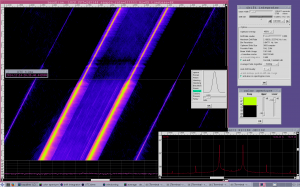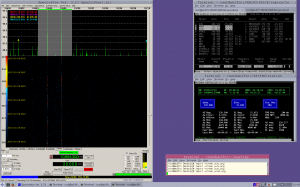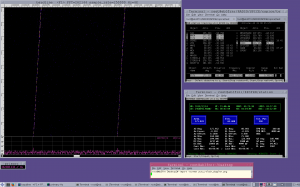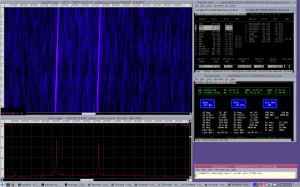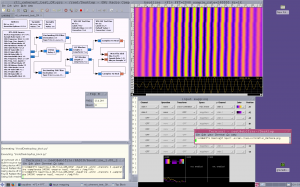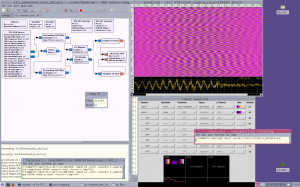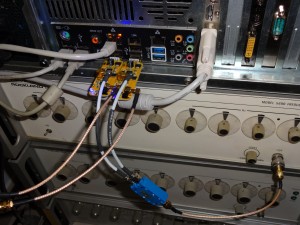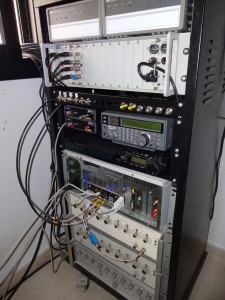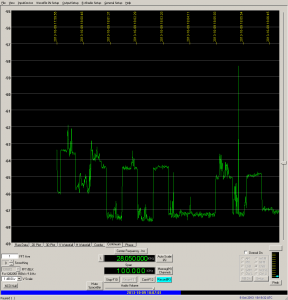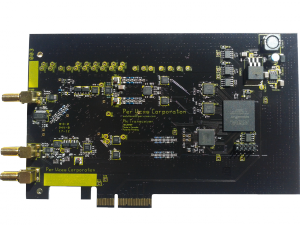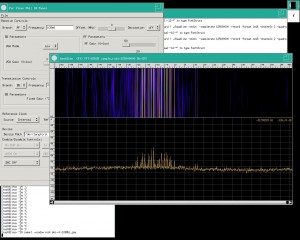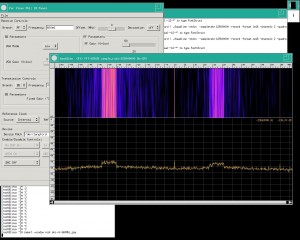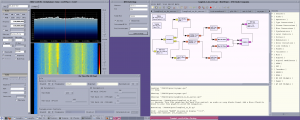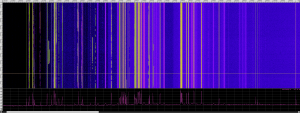Integrating the Yutu using baudline the signals recorded during the seperation from the Chang’e 3 you can see two signal variations. At the 20:27:31 UTC during two minutes aprox the signal was more weak and scince the 20:35:40 UTC the signal was boosted. Then the separation was before of the 20:40 UTC ?
Category Archives: SDR
Successful reception of the Yutu landing
Yesterday the Chang’e3 spacecraft andt the Yutu rover was landing successfuly. I was start to track the moon since the 18:30 to the 22:30 UTC. And I was listen Yutu from the start of my window and the signal was over 15dB of SN at 1Hz of BW. The frequency of the rover is 8462.08000MHz with the moon doppler of -0.6Hz/s of aprox. The signal was easy to listen in the earphones, and sounds like a some kind of morse.
For this event I was setup two receivers, as main a AOR AR5000 and Rfspace SDR14. As second receiver a rtl-sdr doongle with r820t tuner and baudline.
The command line to use rtlsdr with baudline was:
rtl_fm -g 44 -d0 -f$1 -s 250000 -F -U | ./baudline.static -stdin -samplerate 250000 -channels 1 -session rtlsdr1chUSB0 -basefrequency $1
Now you can listen how sounds the data stream from Yutu. A short audio record of the signal demodulated:
RTLSDR Coherence first test
The first test to see the coherence of two rtlsdr in realtime consist in do a cross-correlation of the two dongles, the cross-correlation is a measure of similarity of two signals.
To do the test I used baudline and tuned to a local VOR/DME. Here in the first picture can see some coherence of the two dongles using one antenna to every rtlsdr:
Here the result if disconnect one antenna:
RTLSDR Coherence setup
After the nice videos that Juha Vierinen has shared, looks that some people is interested in use multiple rtlsdr coherent for radar applications for example. I’m starting my experiments with this setup:
My setup consist in two rtlsdr dongles with r820t tunner with the xtal removed, connected to a PTS-160 Synthsesizer tunned at 28.8 MHz and locked to 10 MHz GPS reference.
With coherence using radar mehtods, you can get cool images like:
Say Hi to Juno
Recently a nice activity for the Ham radio community was organizated from the JPL. The idea is that the spacecraft instruments can detect a message transmited by the Ham radio operators, here all the info. Waiting the definitive plot from the JPL here my the plot that I was record using a Rfspace SDR-14 in continuum mode, recoerding the slice from 28.0 to 28.5MHz:
Thanks to the JPL people to this kind of activities for the Amateur Radio community.
73! eb3frn
The PHI / Notcar SDR
One of my challenges is detect a pulsar using my small dish antenna. The pulsars are vey weak radiosources and not easy to get for the amateurs, maybe be the most difficult signal to detect. The only way to detect the strong pulsars with my antenna is using a massive bandwith. Looking the sdr radios market dont find any radio that give-me more than 20Mhz of BW inside of the PC to process it, the trouble is the bootleneck is the USB and Ethernet. But in the middle of 2012 appears a new sdr radio called PHI from a young canadian company called Pervices. Looks that can give me the bandiwth that I need to detect pulsars.
The PHI / Notcar is a 8x PCI-E with two 125Msps ADC and one 250Msps DAC handled by a Altera FPGA. The card gives up to 250Mhz of bandwitdh and a throughput of 5Gbps. The card have two RX branches one working in base band with real type signal ideal for IF, and a I/Q type signal in a direct conversion setup that covers up to 4GHz.
The most important before to start the card, is get a very power PC. You will need a lot of horsepower to process the high samplerate that handle the card. In my case I’m using a Intel I7 3770k that is performing very well.
The first impression is very good, is a card with a lot of potentail, but is important to say that it not is a plg&play finished product, really is a open development platoform. To get good results, you will have to put a good rf frontend.
This are the screenshots of my firsts tests:
I developed a small rtlsdr server tha handle any input, that I’m using to feed the SDR# from the PHI:
Here one of my firsts success, this a screenshot from a L-band Inmarsat satellite, showing in realtime from 1520 to 1560Mhz, getting more than 15fps:
Now I’m learning to use Sigproc and Presto, to use it with the PHI.
Note: Recentlly Pervices has upgraded the PHI card with some new features, and now the card is called Notcar.
